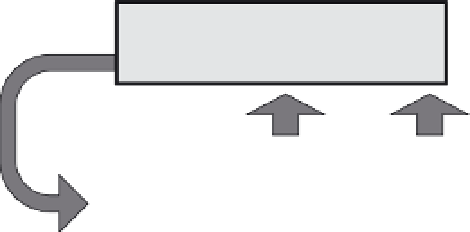Biology Reference
In-Depth Information
Mood/cognition/mental health
Sleep/wake cycle
Social
timing
Circadian
system
Homeostat
Light
Dark
Figure 11.2
The key components in the regulation and maintenance of the sleep/wake
cycle and its relationship to mood/cognition and mental health. The sleep/wake cycle is
regulated by three key drivers which are illustrated here: (i) The endogenous 24-h body
clock/circadian system, via the master circadian pacemaker located within the sup-
rachiasmatic nuclei (SCN) drives wakefulness throughout the day and sleep during
the night. The SCN regulates directly multiple neurotransmitter systems that either drive
or modulate sleep, including the hypothalamo-pituitary-adrenal (HPA) axis and mela-
tonin from the pineal gland. (ii) Wake-dependent homeostatic drivers (such as adeno-
sine) build-up within the brain to generate a sleep pressure during the day. This
“hourglass oscillator” drives increased sleep pressure during wake, which is
counteracted by the circadian drive for wakefulness. Sleep pressure is dissipated during
sleep, and sleep is maintained by the circadian drive for sleep. In general terms, wake
occurs when sleep pressure is low and the circadian drive for sleep ceases. (iii) Social
timing frequently forces an exogenous sleep/wake pattern on an individual's behavior.
The light/dark cycle plays a key role in sleep regulation acting to (a) entrain the SCN to
the 24-h cycle of dawn and dusk; (b) alter the production or different hormones asso-
ciated with activity and rest, most notably melatonin; (c) modulate the HPA “stress” axis;
and (d) elevate or suppress levels of mood and cognitive function. Social behaviors will
also drive an individual's exposure to the light/dark cycle, and hence circadian entrain-
ment and alertness. The duration, quality, and efficiency of sleep have a direct impact
upon mood, cognitive processing, and mental health.
individual's sleep-wake behavior, for example, by actimetry, sleep-logs, or
on sleep behavior on work-free days (the time of mid-sleep, MSF—the mid-
point between sleep onset and sleep end), which is then corrected for “over-
sleep” on free days (MSF
sc
); sleeping in on free days reflects compensation
for accumulated sleep debt during the workweek (see below). The detailed































Search WWH ::

Custom Search